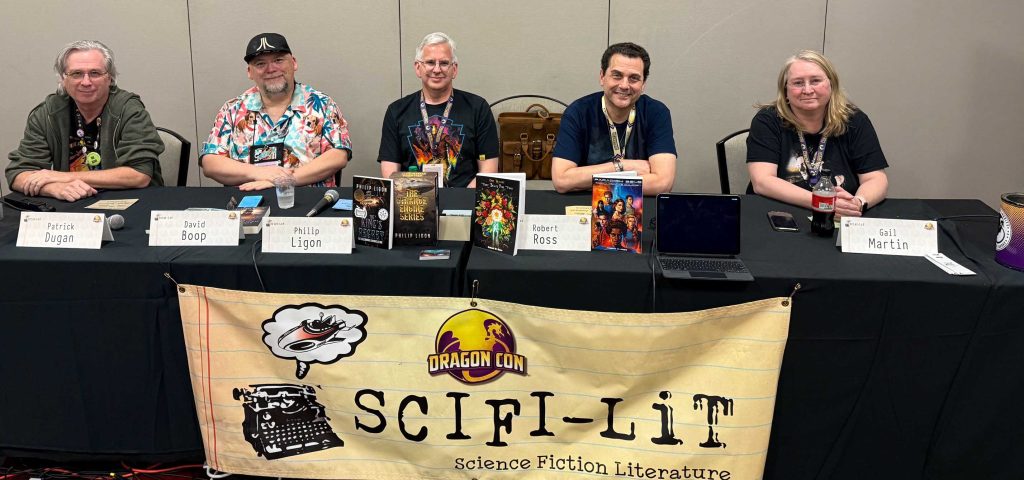On Sunday at 4PM, the Hyatt Embassy AB filled with fans of gears, goggles, and “what ifs” for the “Steam Power is SF… Right?” panel on the Sci-Fi Literature track. Moderator Gail Martin, an urban fantasy and paranormal author, was joined by authors Patrick Dugan, David Boop, Philip Ligon, and Robert Ross. Together, the authors explored the roots, inspirations, and future of steampunk, showing how a subgenre built on brass and imagination continues to evolve.

Martin started the panel by asking the authors how they discovered steampunk. Boop traced his journey back to writing a western murder mystery that led him into “weird westerns” and then to steampunk. “Once I was exposed to it, I realized I’d been enjoying it for years without knowing it was a genre,” he said.
Ligon pointed to Cherie Priest’s Boneshaker as his gateway, while Ross credited his son for introducing him to anime like Violet Evergarden, which led him to ideas for his next project. Martin cited Wild Wild West as her early inspiration. “Victorians as they never were but should’ve been,” she said, recalling her love of Robert Conrad and Dr. Loveless with all his cool gadgets.
As for inspirations for their books, Boop liked to find “the cracks in history” during his research for a novel. He described uncovering real-world oddities such as a steam-powered airplane built a year before the Wright brothers built their plane, or dime novels like Steam Man of the Prairie, about a man who built a robot to bring rain. “It’s fun to play with these holes in history,” he said.
Dugan’s inspirations included the show Forged in Fire, which led to him taking blacksmithing classes and sparked the idea for a character who lost an arm and the question of how the character would continue his work. Ligon, with a mechanical engineering background, relishes the technical side: “What if you advanced steam power and did different things with it? Or combined it with magic?”
Ross also enjoys fusing science with magic. He played with the idea that energy cannot be destroyed and just changes form. He had an entity that died, became magic, and made all these impossible technologies work. Then he took a SF cast with lots of technology and brought it to the magical world, and the characters think, “None of this should work,” he said with a laugh, “but it’s so cool.”
Each author’s steampunk world has its own flavor. Ligon’s characters built a machine that opens a portal to a magical realm within Victorian England. Boop experiments across weird westerns, as well as colonists reaching a new planet only to have their technology stop working, forcing them to revert to steam-powered technology. Dugan layers deception and politics into his settings, where the government uses technology to simulate magic and keep enemies at bay. Martin’s own novels bring steampunk to Pittsburgh’s 1890s steel mills, with heirs to a company, a shadow oligarchy, and underwater treasures.
While the authors attempt to ground their inventions in real science, all admitted to embracing “hand wavium” when needed. “I’m a shareholder in hand wavium,” Ross joked, “but only one share per book.” He also likes to have a skeptic character who acts as proxy for the audience to question how the technology works so the reader stays immersed in the story.
As for the future of steampunk, Martin noted, “We’re in another gilded age. We have tech bros instead of steel barons.” With that, the world is facing similar economic conditions to those present in the late 19th century. Steampunk gives us a way to examine the past that might have been and ask if we can do better this time around.
